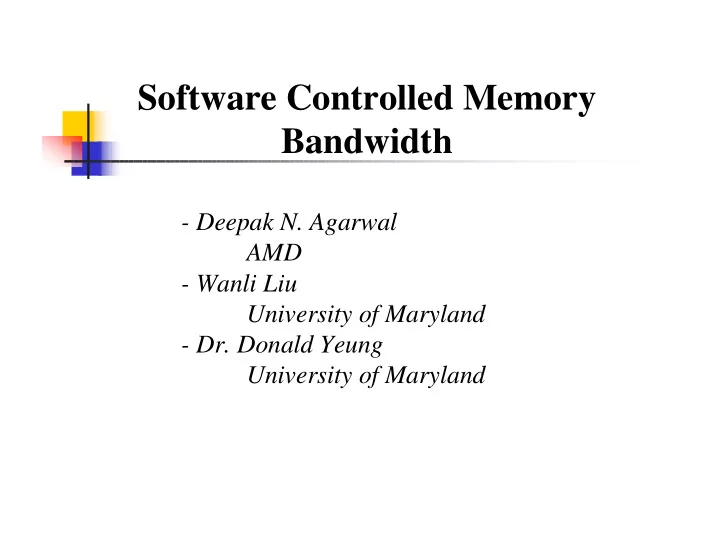

Software Controlled Memory Bandwidth - Deepak N. Agarwal AMD - Wanli Liu University of Maryland - Dr. Donald Yeung University of Maryland
Factors Stressing Memory Bandwidth •Processor Improvement -Clock Speed Increase -More ILP •Latency Tolerance Techniques Used -Non-Blocking Caches, Prefetching, Multi-Threading,etc • Pin Limitation and Packaging Considerations
Bandwidth Impacts Performance From 2Gb/s to 4Gb/s performance improves by 38%
Opportunity Overall fetch wastage = 51.3%
Dense/Sparse Applications ………………… ………………… …………………… …………………… …………………… …………………… …………………… ………………… ………………… + = ………………… ………………… ………………… ………………… ………………… ………………… Matrix Addition Linked List for(j=0;j<X;j++){ While(ptr){ sum+=ptr � data; for(i=0;i<X;i++){ ptr=ptr � next; C[j][i]= A[j][i] + B[j][i]; } } }
Hardware vs. Software Techniques Spatial Footprint Predictor (S.Kumar, ISCA’98) • Hardware Technique • Selectively Prefetches Required Data Elements Contribution • Complexity effective Software Centric Approach • Sparse Memory Accesses Detected at Source Code Level
Roadmap • Motivation • Our Technique • Experimental Results • Conclusion
Approach • Identify Sparse Memory Accesses • Compute Transfer Size • Annotate Selected Memory Instructions Sparse Compute load size transferring just req. bytes While(ptr){ ptr=ptr � next; } Sparse code Processor Cache Memory
Sparse Memory Access Patterns • Affine Array Accesses • Indexed Array Accesses • Pointer Chasing Accesses
Affine Array Accesses for(i=0;i<X;i+=N){ sum+= A[i]; }
Indexed Array Accesses for(i=0;i<N;i++){ sum+= A[B[i]]; }
Pointer Chasing Accesses for(ptr=root; ptr; ){ sum+=ptr � data; ptr=ptr � next; }
Computing Transfer Size for(i=0;i<N;i++){ sum+= A[B[i]]; Size #1 – Normal Load } Size #2 – sizeof(A[i])(Sparse Load) Load1 Load2 Structure Layout While(ptr � fwd){ sum+= ptr � data1; data1 Size #1 ptr = ptr � fwd; data2 16 bytes } back Size #2 fwd Load #1 4 bytes Load #2
Annotating Memory Instructions Memory Instructions with Size Information
Sectored caches
Fetching Variable Sized Data Sector Hit/ Sector Hit/ . Cache Block Miss Cache block miss . . . Sector Miss Sector Miss Ld R0(&R1) Ld R0(&R2) Ld8 R0(&R3) Ld16 R0(&R4) Ld R0(&R5) . . . . Lower Level Memory
Application Overview IRREG Scientific Indexed Array MOLDYN Scientific Indexed Array NBF Scientific Indexed Array HEALTH Olden Ptr. Chasing MST Olden Ptr. Chasing BZIP2 SPEC2000 Indexed Array MCF SPEC2000 Affine Array, Ptr. Chasing
Experimental Methodology Cache Simulations Processor and Memory parameters • Traffic and Miss-rate Behavior Processor Model Super scalar • SFP-Ideal (8 Mbytes) Processor Speed 2 GHz • SFP-Real (32 Kbytes) Issue Width 8 Performance Simulations Memory Bandwidth 2 GB/s • Comparison with Conventional Memory Latency 120 • Latency Tolerant Study Memory Bus Width 8 Bytes -Prefetching DRAM Banks 64 • Bandwidth Sensitivity
Traffic Behavior MCF Annotated Conventional SFP-Real SFP-Ideal MTC Traffic Reduction for MCF – 57%
Traffic Behavior Irreg Moldyn NBF Health MST BZIP2 Overall Traffic Reduces by 31 - 71%
Miss-Rates MCF Annotated Conventional SFP-Ideal Miss rate increases by 18%
Miss-Rates Moldyn NBF Irreg Health MST Bzip2 Overall Miss rate increases by 7- 43%
Baseline Performance Overall performance improves by 17%
Baseline Performance with Prefetching Overall performance improves by 26%
Bandwidth Sensitivity
Bandwidth Sensitivity Irreg Moldyn NBF Bzip2 Health MST
Conclusion • Complexity effective way for memory bandwidth bottleneck • Sparse memory references can be identified at source code level • Software can effectively control memory bandwidth • Performance numbers: -Cache traffic reduces by 31-71%; miss rates increases by 7-43% -17% performance gain over normal caches -Annotated s/w prefetching gains 26% over normal prefetching • Our technique looses effectiveness at higher bandwidth
Recommend
More recommend